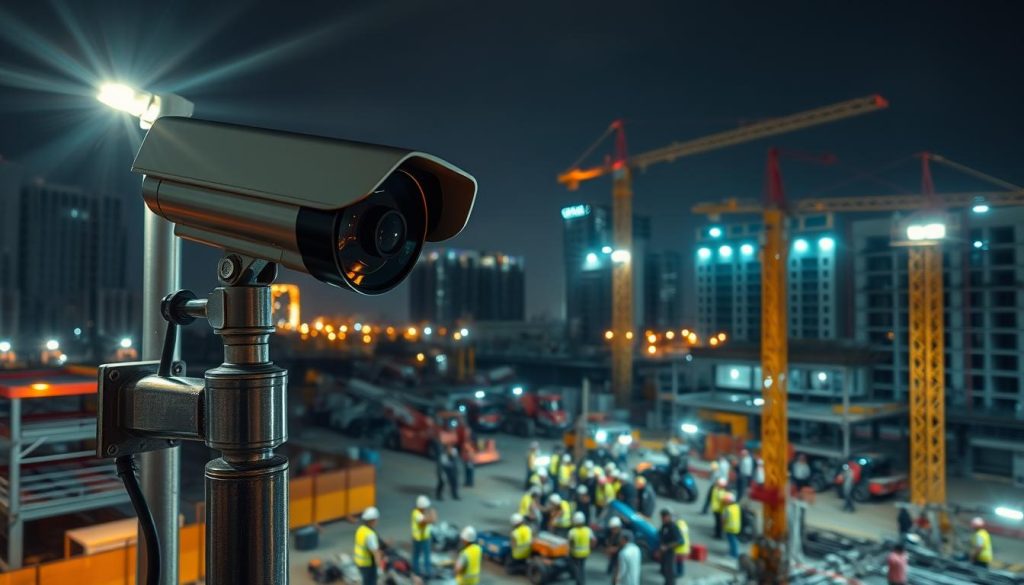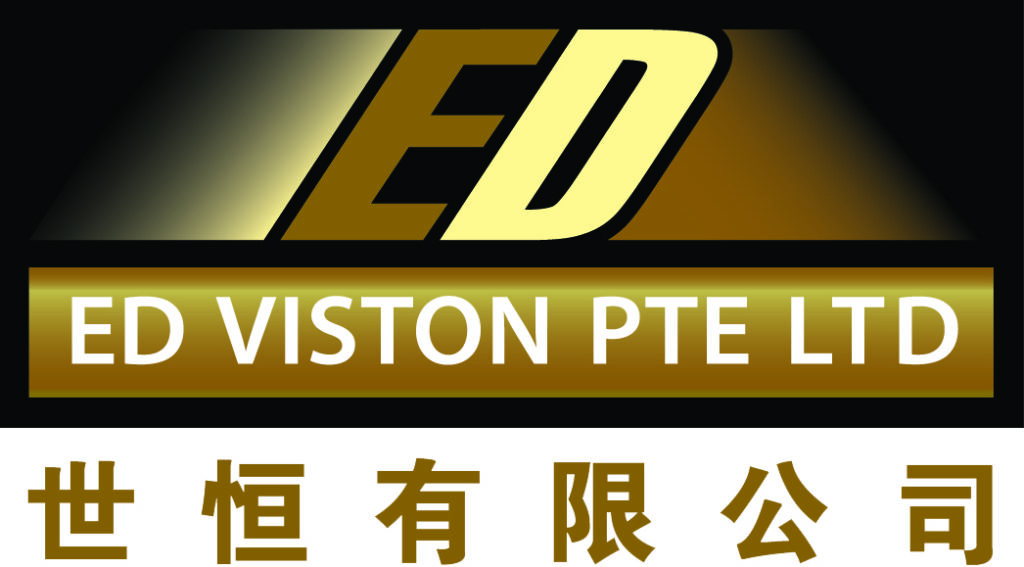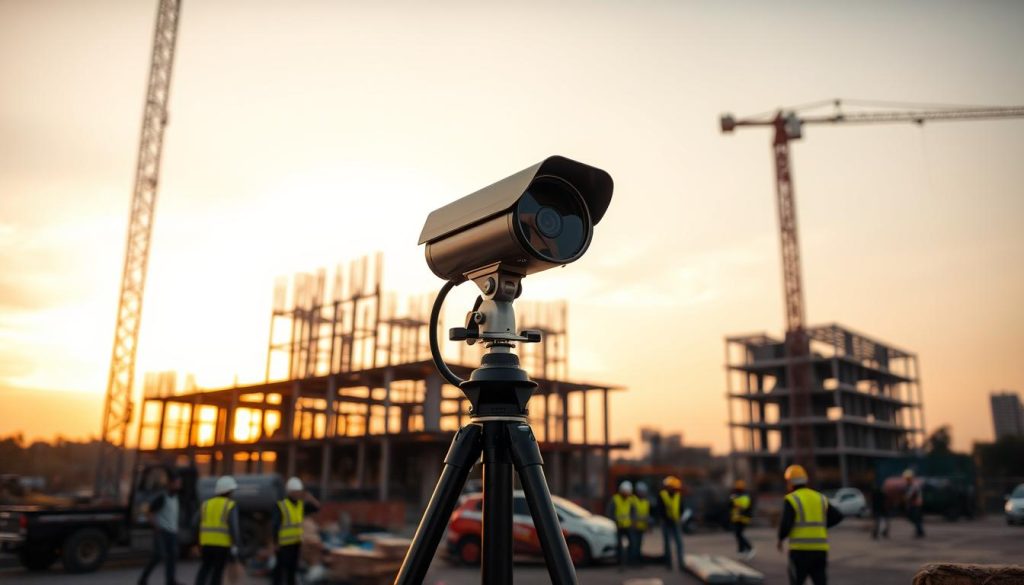Construction sites face significant challenges, from theft to compliance with local regulations. In the U.S., theft losses in the industry range between $300 million and $1 billion annually. This highlights the need for robust surveillance systems to protect assets and ensure project continuity.
In Singapore, the Ministry of Manpower (MOM) has introduced new regulations mandating Video Surveillance Systems (VSS) for projects exceeding $5 million, effective June 2024. This move underscores the importance of compliance while addressing site safety and security concerns.
For businesses, investing in these systems offers a dual advantage: meeting regulatory requirements and providing cost-effective protection. Local providers like Wen Hong Engineering (+65 60135960) offer tailored solutions to meet these needs.
This guide will explore costs, features, regulations, and implementation strategies to help you make informed decisions for your construction site.
Key Takeaways
- Construction theft in the U.S. causes annual losses of $300M-$1B.
- Singapore mandates VSS for projects over $5M starting June 2024.
- Surveillance systems ensure compliance and protect assets.
- Local providers like Wen Hong Engineering offer tailored solutions.
- This guide covers costs, features, regulations, and implementation.
Why Construction Sites Need Security Cameras
Protecting construction sites from theft and vandalism is a growing concern for project managers. These incidents not only lead to financial losses but also disrupt project timelines. With assets like machinery and materials often left unattended, the need for reliable surveillance becomes critical.
In Singapore, the Ministry of Manpower (MOM) has introduced strict regulations to address these challenges. Starting June 2024, projects exceeding $5 million must implement Video Surveillance Systems (VSS). This mandate ensures compliance while enhancing site safety and reducing risks.
The Rising Threat of Theft and Vandalism
Theft and vandalism are major issues that construction sites must address. High-value equipment and materials are often targeted, leading to significant financial losses. Without proper measures, these incidents can delay projects and increase costs.
Surveillance systems act as a deterrent, discouraging unauthorized access. They also provide evidence in case of incidents, helping authorities take swift action. For businesses, this means better protection and peace of mind.
Regulatory Requirements in Singapore
Singapore’s MOM has set clear guidelines for VSS implementation. Systems must meet specific standards, including 1080p resolution, 12 frames per second, and 30-day data retention. These requirements ensure high-quality monitoring and reliable evidence collection.
To support businesses, the Productivity Solutions Grant (PSG) covers up to 80% of VSS implementation costs. This makes compliance more affordable while reducing the risk of penalties, which can reach up to $50,000 for non-compliance.
For projects under $5 million or temporary structures, exceptions apply. However, investing in surveillance systems is still a smart move. The installation cost of around $25,000 is far lower than the potential penalty and losses from theft.
Companies like Wen Hong Engineering offer compliance-ready solutions tailored to construction sites. Their expertise ensures seamless implementation, helping businesses meet regulations while enhancing site safety.
Understanding Jobsite Security Camera Rental Cost
Budgeting for surveillance solutions requires a clear grasp of both upfront and ongoing expenses. Whether you’re managing a short-term project or a long-term site, understanding the financial implications of renting versus purchasing is essential.
Factors Influencing Rental Prices
Several factors affect the price of renting surveillance systems. These include the number of devices needed, the duration of the rental, and the features required. For example, high-resolution cameras with advanced monitoring capabilities may cost more but provide better protection.
Additionally, local regulations and compliance standards can influence pricing. In Singapore, systems must meet specific requirements, such as 1080p resolution and 30-day data retention. These standards ensure quality but may increase costs.
Cost Comparison: Renting vs. Purchasing
When comparing renting to purchasing, the total cost of ownership (TCO) is a critical factor. On average, purchasing a system costs around $1,330, while renting can be as low as $400 per month. For short-term projects, renting saves up to 37% over three years.
Purchased systems also face significant depreciation, losing up to 60% of their value in just two years. Renting eliminates this concern, offering a more flexible and cost-effective solution. Insurance premiums can also be reduced by 15% when using rented systems, adding to the savings.
Scalability is another advantage of renting. As project phases change, you can easily add or remove devices without incurring additional costs. For long-term users, providers like Wen Hong Engineering offer rent-to-own programs, combining flexibility with eventual ownership.
By carefully evaluating these factors, you can choose the best option for your project, ensuring both financial efficiency and robust protection.
Types of Security Cameras for Construction Sites
Choosing the right surveillance system for construction sites involves understanding the different types of devices available. Each type offers unique advantages depending on your project’s needs. From fixed to mobile options, the right choice can enhance site safety and compliance.
Fixed vs. Mobile Cameras
Fixed cameras are ideal for monitoring specific areas like entry points or equipment storage. They provide consistent coverage and are often more durable in harsh environments. For tropical climates like Singapore, an IP67 rating is essential to withstand heavy rain and humidity.
Mobile cameras, on the other hand, offer flexibility. They can be moved as project phases change, ensuring coverage where it’s needed most. These devices are particularly useful for temporary sites or areas requiring frequent adjustments.
Key Features to Look For
When selecting a surveillance system, prioritize 4K resolution with 120dB WDR for clear license plate recognition. This ensures detailed footage even in challenging lighting conditions. AI analytics can reduce false alarms by 73%, improving efficiency and reducing unnecessary alerts.
Another critical feature is the operational temperature range. Devices should function seamlessly in temperatures from -40°C to 70°C, ensuring reliability in extreme weather. For low-light performance, compare options like Hikvision (0.0001 lux) and Dahua (0.001 lux) to find the best fit for your site.
For enhanced perimeter security, consider thermal imaging add-ons. These features detect heat signatures, providing an extra layer of protection against unauthorized access. Providers like Wen Hong Engineering offer tailored solutions to meet these advanced needs.
Benefits of Renting Security Cameras
Renting surveillance systems offers a practical approach to managing construction site safety. It provides flexibility and scalability, making it ideal for businesses with varying needs. Whether you’re handling a short-term project or need temporary coverage, renting ensures you have the right tools without long-term commitments.
Flexibility and Scalability
One of the biggest advantages of renting is the ability to scale your system as needed. For example, a typical 4-camera setup ranges from $600 to $1,600, depending on the duration and features. This flexibility allows you to adjust coverage as project phases change, ensuring you’re always protected.
Additionally, renting eliminates the need for large upfront investments. For a 6-month project, renting can save up to $4,600 compared to purchasing. This makes it a cost-effective choice for businesses with limited budgets or short-term needs.
Cost-Effective Solutions for Short-Term Projects
Renting is particularly beneficial for short-term projects. Maintenance is often included, saving you $200 to $400 per month. This reduces operational hassles and ensures your system runs smoothly without extra expenses.
Tax benefits are another advantage. Rental costs are 100% deductible, while purchased systems only allow for 20% depreciation. This can lead to significant savings during tax season.
For HDB/BTO projects, providers like Wen Hong Engineering offer a 10% discount, making renting even more affordable. Insurance premiums can also be reduced by up to 15%, adding to the hidden savings.
By choosing to rent, you gain access to high-quality systems without the long-term commitment. This approach ensures your project stays on track while keeping costs under control.
How to Choose the Right Rental Provider
Selecting the right provider for your surveillance needs can make or break your project’s success. With 30% of providers excluding installation in their base pricing, it’s crucial to evaluate your options carefully. A reliable provider ensures your systems are not only effective but also compliant with local regulations.
Evaluating Provider Expertise and Services
Start by assessing the provider’s experience in handling construction site security. Look for companies with a proven track record in delivering tailored solutions. For instance, Wen Hong Engineering specializes in compliance-ready setups, ensuring your project meets Singapore’s stringent standards.
Ask about their installation process and whether it’s included in the rental cost. Some providers may charge extra, so clarity upfront can save you from unexpected expenses. Additionally, verify their maintenance schedules—bi-weekly checks are recommended to keep your systems running smoothly.
Questions to Ask Before Renting
Before committing, ask critical questions to ensure you’re making an informed decision. Clarify data ownership—who has access to the footage? Confirm encryption standards, with AES-256 being the minimum requirement for data protection.
Inquire about vandalism replacement policies. Accidents happen, and knowing your provider’s response can save you time and money. Finally, request references from similar-scale projects to gauge their reliability and expertise.
“A trusted provider doesn’t just offer equipment; they deliver peace of mind,” says a seasoned project manager. By asking the right questions, you can ensure your site remains secure and compliant throughout the project.
Installation and Maintenance of Rental Cameras
Effective installation and maintenance are critical for maximizing the performance of surveillance systems. A well-executed setup ensures seamless monitoring, while regular upkeep keeps the systems running efficiently. This section covers key aspects of professional installation and proactive maintenance.
Professional Setup and Support
For reliable monitoring, professional installation is essential. NEMA 4X-rated equipment is recommended for monsoon resilience, ensuring durability in harsh weather conditions. Backup power options, such as solar or diesel generators, provide uninterrupted operation during outages.
Escalation protocols, including SMS alerts to up to five contacts, ensure swift responses to incidents. Remote diagnostics can prevent 85% of downtime by identifying issues before they escalate. These features enhance the reliability of your surveillance setup.
Ensuring Continuous Monitoring
To maintain optimal performance, regular maintenance is crucial. Quarterly lens cleaning schedules prevent dirt buildup, ensuring clear footage. AI-powered detection reduces false alerts by 60%, improving the accuracy of your monitoring system.
Storage solutions, such as 4TB drives, cover 30-day data retention requirements. This ensures compliance with local regulations while providing ample space for evidence collection. By combining professional setup with consistent maintenance, you can achieve uninterrupted security for your site.
Integrating Security Cameras with Existing Systems
Seamless integration of monitoring tools enhances overall site management and safety. By combining advanced features with your current workflows, you can achieve better oversight and faster response times. This ensures that your project remains on track while minimizing risks.
Enhancing Site Safety with Advanced Features
Modern surveillance systems offer features like AI-powered detection and geofenced alerts. These tools reduce false alarms by up to 73%, ensuring that your team focuses on real threats. Customizable dashboards allow you to prioritize critical areas, improving efficiency.
For 4G-connected sites, bandwidth management is crucial. Optimizing data usage ensures smooth remote monitoring without interruptions. Providers like Wen Hong Engineering offer solutions tailored to these needs, ensuring seamless integration.
Real-Time Monitoring and Alerts
Real-time alerts are essential for effective response. With a latency threshold of 500ms, push notifications outperform email alerts in speed and reliability. Customizing alerts by user role ensures that the right people are notified at the right time.
Live dashboards provide a comprehensive view of your site’s status. Uptime KPI reporting, offered by Wen Hong, ensures that your systems are always operational. This level of oversight enhances overall security and project efficiency.
Best Practices for Construction Site Surveillance
Implementing effective surveillance strategies on construction sites requires a focus on both placement and upkeep. Properly positioned devices and regular maintenance ensure optimal performance and compliance with local regulations. These practices not only enhance site safety but also extend the lifespan of your systems.
Optimal Camera Placement
Strategic placement of surveillance devices is crucial for comprehensive coverage. Focus on high-risk areas like entry points, equipment storage, and perimeter zones. Ensure devices are mounted at the right height and angle to capture clear footage.
For sites in tropical climates, like Singapore, consider weather-resistant features. Devices with IP67 ratings can withstand heavy rain and humidity, ensuring uninterrupted monitoring. Rotating PTZ cameras weekly also prevents motor wear and maintains flexibility.
Regular Maintenance and Updates
Consistent upkeep is essential for reliable performance. Bi-monthly checks can prevent 92% of system failures, saving time and resources. Schedule firmware updates during non-peak hours to avoid disruptions.
During the monsoon season, maintain a cleaning log to ensure lenses remain clear. Calibrate IR illuminators quarterly for optimal low-light performance. Annual cybersecurity audits are also recommended to protect your solutions from potential threats.
By following these best practices, you can ensure your surveillance setup remains effective and compliant throughout your project.
Case Studies: Successful Implementations in Singapore
Real-world examples highlight the transformative impact of surveillance on construction sites. In Singapore, advanced monitoring systems have not only reduced risks but also improved overall project efficiency. These case studies provide valuable insights into how businesses can achieve compliance and enhance safety.

Lessons Learned from Real-World Projects
One key takeaway is the importance of proactive measures. For instance, the Keppel Bay project saw an 80% reduction in insurance premiums after implementing a robust surveillance system. This highlights the financial benefits of investing in security.
Another lesson is the need for compliance. Across 14 sites, 100% adherence to MOM regulations was achieved, ensuring smooth operations and avoiding penalties. Remote progress tracking also allowed project managers to monitor developments in real-time, improving decision-making.
How Security Cameras Reduced Theft and Improved Safety
Surveillance systems have proven effective in deterring theft and vandalism. At one site, a documented 3:1 ROI was achieved by preventing vandalism-related losses. This underscores the value of these systems in protecting assets.
Night shift accidents were reduced by 67%, thanks to enhanced visibility and monitoring. Faster police report filing, facilitated by clear footage, also improved response times. These outcomes demonstrate the dual benefits of safety and efficiency.
- Documented 3:1 ROI from vandalism prevention
- Achieved 100% MOM compliance across 14 sites
- Reduced night shift accidents by 67%
- Enabled remote progress tracking for PMs
- Facilitated 92% faster police report filing
Making the Right Choice for Your Construction Site
Choosing the right approach for your construction site’s needs requires careful consideration of multiple factors. Duration, budget, and compliance are key elements to evaluate. Understanding the Total Cost of Ownership (TCO) versus your project’s lifecycle ensures financial efficiency.
When deciding between renting and purchasing, weigh the benefits of flexibility against long-term investments. For short-term projects, renting often proves more economical. However, for extended timelines, purchasing might offer better value.
With Singapore’s MOM enforcement deadlines approaching, compliance is non-negotiable. Ensuring your site meets these standards is crucial to avoid penalties and enhance safety.
Take immediate action by scheduling a free security audit with Wen Hong Engineering. Their expertise ensures tailored solutions that align with your project’s requirements. Call +65 60135960 today to secure your site’s future.

